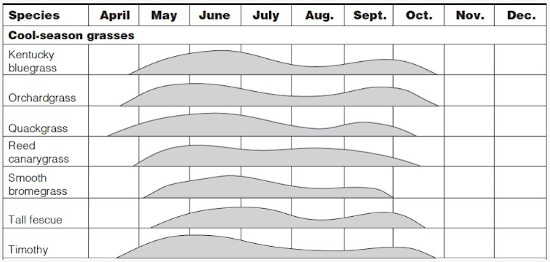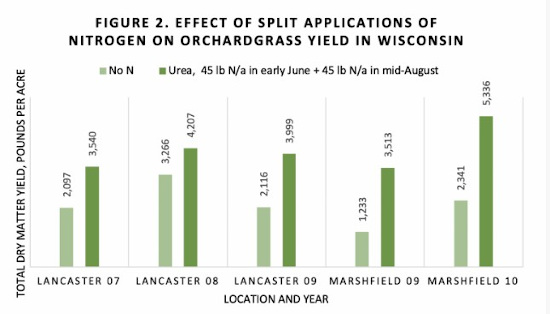By Bill Halfman and Carrie Laboski et.al.
Recently, the USDA NASS reported that Wisconsin’s forage inventory is the lowest it has been in 70 years. Low forage inventory is a result of several seasons with excessive rainfall and winter weather that resulted not only in forage winterkill, but also higher need for cattle feed. These conditions have led farmers to investigate emergency and non-routine forage crops to help supply enough forage for cattle needs.
In the quest for additional forage production options, sometimes the lowest cost and potentially easiest options may be overlooked. A good question to ask is, “Am I managing my pasture resource to optimize forage production?” While grazing cattle will deposit some nutrients in manure and urine, the amount deposited is less than the amount removed in milk production, animal growth and maintenance. In addition, animals do not deposit nutrients evenly across a pasture and some nutrients may be lost. Nitrogen is very mobile in the environment and can be lost through leaching, denitrification, or ammonia volatilization. Low levels of soil available phosphorus or potassium or low soil pH can limit grass pasture yield and response to nitrogen fertilizer.
Whether a pasture has improved (bromegrass, orchardgrass, fescue, ryegrass, timothy) or unimproved (primarily Kentucky bluegrass) forage species, there is an opportunity to produce additional forage at a very low cost by utilizing a fertilization plan. Consult soil test results to guide applications of phosphorus, potassium, and lime. If soil test results are more than four years old, it is important to take new soil samples ahead of fertilizer application to ensure a sound investment in fertilizer and lime. When soil sampling a pasture, avoid, or sample separately, areas where cattle frequently congregate (under trees, near water tanks, etc.). Focus on sampling and applying fertilizer on the areas of the pasture where forage production potential is the highest.
Not all grass pastures are necessarily good candidates for fertilizer application. Use extreme caution when applying fertilizer to areas that are steep or wet due to multiple safety risks during application. These areas of a pasture will rarely give a return on investment worth the risk!
On soils with 2.0 to 9.9% soil organic matter, 100 or 130 pounds of nitrogen per acre is recommended on unimproved and improved grass pastures, respectively. The amount of nitrogen deposited by cattle should be subtracted from these amounts to determine the amount of nitrogen fertilizer to apply. Refer to UW Extension publication
A4034 Soil Fertility Guidelines for Pastures in Wisconsin for details on manure nutrient credits. Research in Wisconsin has demonstrated that it is best to split apply nitrogen fertilizer with half applied in early June and the other half applied in mid-August. This application timing helps extend the early spring growth period and helps boost the accelerating late summer growth curve common to cool season grasses (See Figure 1).

How much additional forage production can we expect? University of Wisconsin-Madison research conducted at Marshfield and Lancaster Ag Research Stations evaluated the efficacy of 45 pounds per acre of actual N, applied as urea, in early June and again in mid-August to increase dry matter yield of orchardgrass. Yield increased approximately 0.75 tons of dry matter per acre at Lancaster on a well-drained soil and 1.3 tons of dry matter per acre at Marshfield on a somewhat poorly-drained soil (See Figure 2). Cattle were not grazed in this study; however, orchardgrass was clipped five times to simulate cattle grazing. In a similar trial conducted by University of Minnesota at Grand Rapids, a 1.5 ton per acre increase in yield was observed with two applications of 50 pounds of nitrogen per acre. Pasture yield response to fertilizer nitrogen will vary based on stand density and composition, soil properties, and weather. A reasonable expectation is one ton of dry matter per acre increase through an investment in fertilizer. At current prices, an investment of $60 in nitrogen fertilizer and application can yield around $120 worth of additional forage.

Established pastures that are a grass-legume mix, do not require any nitrogen beyond what is deposited by grazing animals. Applying nitrogen to a grass-legume mix pasture can result in the grass crowding out the legumes.
Once a decision has been made to fertilize a pasture, it is important to implement a grazing plan to use as much of the additional forage produced as possible. Grazing plans are customized for each farm’s unique situation. Most plans will likely involve some level of moving cattle around from pasture area to pasture area, to improve utilization of the extra growth. Plans may also include harvesting some of the pasture areas for hay and/or using drift fences in the fall to help extend the grazing season.
Fertilizer application to grass pasture may be a cost effective and easy option to increase the amount of forage available on a farm. For additional information about fertilizing pastures, collecting soil samples, and crediting deposited nutrients consult UW Extension publication
A4034 Soil Fertility Guidelines for Pastures in Wisconsin.